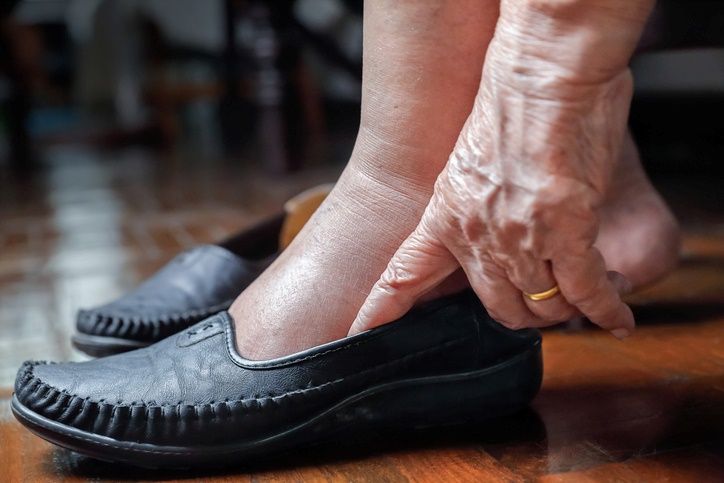Understanding and Appreciating the Benefits of Diabetic Shoes
What Are Diabetic Shoes?
Shoes are shoes, right? When it comes to diabetes, shoes are extremely important and should be chosen with care. Why? Many complications of diabetes involve the feet, from poor circulation to neuropathy to foot ulcers. By choosing the proper shoes, people with diabetes can help protect their feet and sidestep many of these problems.

Key Benefits of Diabetic Shoes
What makes diabetic shoes different from other shoes?
- Diabetic shoes are known for being comfortable. They are soft on the inside, with no irritating stitching, and non-binding uppers. They are available in a variety of widths, and have deep toe boxes, so that the toes can move without pressure. They typically have custom orthotics, to provide superior arch support and cushioning, and stretchable uppers, so that there’s no pressure on swollen feet.
- They are made to provide better motion control. Some shoes force the feet into an unnatural position, so that too much pressure is placed on certain parts of the feet. Diabetic shoes help keep the feet in a natural position, for neutral foot motion. Because of the way they’re designed, they help keep the foot stable in the shoe, so that callouses don’t form.
- Diabetic shoes are breathable and promote circulation. Made of materials that allow natural airflow, these breathable shoes make infections less likely while also providing a comfortable fit. They are also designed to promote optimal blood flow, by adapting naturally to the wearer’s feet. By promoting circulation, they prevent skin from breaking down and reduce the risk of neuropathy and foot ulcers.
- They decrease the pressure put on feet. When a foot lands, it absorbs the shock of about two times the weight of the body. For people with diabetes, this is a major issue, because their bones can potentially be weakened by poor circulation, and this shock can damage them. Diabetic footwear is cushioned to protect the feet from this impact, while assisting with mobility and stability. In addition to shock, which is vertical pressure, there is shear, which is the horizontal movement of the foot inside the shoe. It is important for diabetic shoes to address shear as well as shock, because shear is the force that causes blisters. Their non-binding nature and protection against pressure helps prevent injury.
The Importance of Wearing Diabetic Shoes to Prevent Common Foot Problems
People with diabetes are at risk of a wide range of foot problems. This is why it is so important to wear shoes designed specifically to prevent them. Foot ulcers are one of the biggest risks, formed by friction and pressure that creates small blisters and cuts. While blisters might not be a big deal to healthy people, people with diabetes must be careful, because they can develop into ulcers that sometimes even lead to amputation. Diabetic footwear helps prevent blisters, callouses, and other abrasions because they’re made with soft materials and seamless designs that don’t rub against the skin. This is important, because sometimes, people with diabetes don’t feel minor injuries because of neuropathy, and the injuries can get worse, becoming infected or developing into ulcers. Another problem is that people with diabetes often have swollen feet, and diabetic shoes, with varied width options and comfortable closures can accommodate this swelling while remaining comfortable.
How Diabetic Footwear Impacts Overall Health
Ultimately, diabetic shoes are about more than simply feet. By protecting feet against the risk of injury and infections, they prevent severe outcomes, like amputation. Living with diabetes means remaining vigilant to avoid complications of the illness, and part of this is protecting the feet. In fact, in addition to wearing the right shoes, people with diabetes should check their feet every day for damage, always wear comfortable, clean socks, and avoid going barefoot, even inside the house. Keeping feet healthy is an important factor in safeguarding the overall health of a person with diabetes.
Diabetic Footwear: Shoes and Socks
Do socks matter as much as shoes for a person with diabetes? They absolutely do, and specialized socks and stockings can help reduce moisture, prevent blisters, and enhance circulation. Compression socks are an example of socks that are good for promoting circulation, but it’s important to wear socks that are not too tight. Diabetic socks provide comfort and protection while improving circulation, for healthy feet and a healthy body.
Contact Texas Medical Supply to Find the Medical Supplies You Need
For high-quality medical supplies from industry-leading manufacturers, trust Texas Medical Supply. Our locally owned and operated medical supply company, located in Houston, TX, offers an extensive selection of hospital beds, lift chairs, mobility scooters, power wheelchairs, and more. Whether you are looking to buy or rent medical equipment, we have something to fit your budget and lifestyle, including used equipment at affordable prices. Our team of experts is here for you every step of the way, from helping you make the most of your equipment by delivering equipment directly to your home, to assembling your equipment for you. Shop now to find the medical equipment you need, or contact us through our website for more information.
